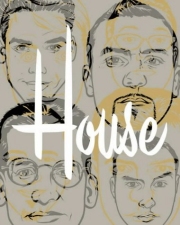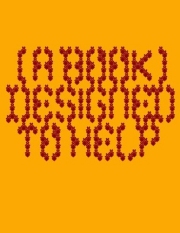Die Gestalten Verlag
Chances are you've heard of Die Gestalten Verlag. You've probably got a stack of its books on your shelf. But how did this publishing giant become the design world's de facto curator? Ian Harrisfinds out.
Die Gestalten's books are a staple on designer's bookshelves the world over. Creatives pore over the weighty tomes, absorbing inspiration, gathering ideas, and breathing in the glorious smell of those extravagant fifth colours.
The firm's lavish titles - which clatter off the presses at astonishing speed - act as weighty archives of design, bringing book fans a regular snapshot of the creative arts. The firm's three founders - Andreas Peyrel, Markus Hollmann-Loges and Robert Klanten (above) - met as industrial design students in the late eighties. Given the job of curating a showcase of industrial design at the Frankfurst Consumer Fair, they soon realised that they were more interested in designing the catalogue.
"We were asked to curate this special prototype show and invite people doing entrepreneurial approaches towards design," says Klanten. "I had a background in music writing and illustration, and so we teamed up. We did the catalogues on some of the first Macs, sold them at the fair, and had a great reaction."
The friends continued to work together into the early nineties, producing flyers and working on projects for record labels. "In design school, I knew early on that I didn't want to go scrubbing foam models at BMW," Klanten admits. "It wasn't for me. But industrial design was pretty influential outside core production activities - it taught you to approach problems in a way unlike other creative industries."
Then, in 1994, the friends had an idea to create a book about an area they felt had until then gone largely undocumented - culture and creativity. "We brought all our contacts together and organised it like a fanzine," Klanten explains. "We invested a lot of work. We didn't have much money, but it was well received and we had lots of companies mailing us asking for copies, as well as bookstores and design houses."
So an idea presented itself: Why not publish books? "I had no clue how best it could be done," says Klanten. "I started doing research and in 1998 felt I had enough insight into the industry to get some money to get a company going. I gave it some momentum with four or five publications. It went well, and we kept turning out books. Now the company is divided into two branches - the design studio with Andreas and Markus - and the other side where I look after publications."
Essential kit
Daily design news, reviews, how-tos and more, as picked by the editors.

Today, no designer's library is complete without a proud stack of Die Gestalten's titles. The firm publishes two types of book: editorial orientated titles and those dedicated to a particular designer. Writing, which surveys graffiti-inspired calligraphy, and Coast to Coast, a compendium of contemporary American design, are perfect examples of the company's varied editorial approach. Die Gestalten brings together and co-ordinates these titles itself: "They're a little bit speculative, entrepreneurial, and a bit more personal in their approach," says Klanten.
The second type of book is generally dedicated to a particular designer: "We look for topics very strongly attractive to designers. We have a well maintained database of designers, so when we know that we want to do a book about this and that, we can get in touch and suggest working together," says Klanten. "We deliberately work like a record label - every book is sold under our name. So if we contact people in Santa Monica, they know our books from the shop next door. They know what the book will be like and what to expect - and they're really helpful."
Publishing compilations is more work for Die Gestalten, but it's worth it - these have proved to be the firm's more successful titles. "In the compilations, we are in control - we choose how it's done with monographs, and we make it clear from the beginning that we don't consider ourselves printers with distribution - we are publishers," says Klanten. "We tell them why we chose them, what material we expect to have in the book, and what the retail price will be, so they can decide whether they want to do it."
Although staff at Die Gestalten are effectively book editors, Klanten insists that they live and breathe design. "We have people here in editor positions who are designers born and bred - most of these guys do work themselves and have projects around them to keep them creative. So when they speak with authors, they speak their language. They know that they aren't some clerk or architect, and in the end the book works because it hasn't been hijacked by something that doesn't belong."
Trend setting
Klanten admits that compilations tend to go better, because book buyers are becoming more work-focused. They want titles to be a useful tool, as well as something to get lost in. "It depends on the zeitgeist around at the time of launch, but generally these days designers go into a shop and have $60 to spend on books, but a few years ago, they'd have had $600," says Klanten.
People have become much more selective about looking for books that make them think. "Right now, people have a different filter that means they buy books that look more usable than others," says Klanten. "Just after tough economics times people are usually hungering for new material, so they'll go out again and look for books that tell them what the other guys are doing."
Having published books for so long, Klanten has developed a good understanding of what drives designers to buy them. "Some titles function as a workhorse in an agency and in the office, he says. "For instance, a book on logo design works in an agency or in an office. It helps you with your design. On the other side are books that function as a kick in the arse for people - to shake them up and refresh their minds."
But Klanten is the first to admit that one reason behind Die Gestalten's strong sales is the fact that designers are hooked on trendy books. "People's love for books is hard to explain," he says. "But a lot of content in modern life has become digital and non-tactile, so there's a fetish aspect to our products. Record and CD covers are becoming more tactile, with music and jewel cases becoming more commoditised. There's a hunger for materials - something with weight - that you can smell and carry and put in your apartment."
Striking a balance between lavish production values and cost is difficult: "We don't want to make books that people can't afford," says Klanten. In the end, though, while other design firms appeal to older audiences with bigger wallets, Klanten vows to remain focused on younger designers. "We target people between 25 and 40 years old. Beyond that - with exceptions - people are more defensive. They try to defend what they have and not acquaint themselves with new perspectives. Younger people are still on a quest - and that's really important."
DIE GESTALTEN ESSENTIALS
Check out these five classic titles from dgv, covering everything from funky logos and typography to larger scale design work

DESIGNED TO HELP
www.designedtohelp.com
Die Gestalten brings together the best efforts of an international dream team of designers, who've donated some of their freshest work to this high quality hardback in aid of the Asian tsunami fund.
PICTOPLASMA
A collection of 2D character designs, indispensable to anyone involved with branding, logo design, games and web design. This book showcases countless styles and techniques involved in bringing characters to life.
HOUSE
Celebrated US typographer House shows off some of its droolworthy calligraphy. This title is especially knee-trembling, even by Die Gestalten's standards, with lavish varnishing, paper stock, and five-colour printing on every page.
HEAD, HEART AND HIPS
This showcase of London design agency Big Active explores the more glamorous side of design - with themes of seduction and pleasure running throughout. Alongside some vintage pieces, there's new work specially commissioned by Big Active.
LOS LOGOS
It's a book full of logos! With over 3,000 works by over 200 designers across 444 pages, Die Gestalten's international bestseller is a trusted manual for any designer ever thrown the last-minute "Oh, and a logo as well" request.
To find out more about Die Gestalten Verlag and its vast back catalogue, visit www.die-gestalten.de. Designed To Help is still raising money - visit www.designedtohelp.com for more details.

The Creative Bloq team is made up of a group of art and design enthusiasts, and has changed and evolved since Creative Bloq began back in 2012. The current website team consists of eight full-time members of staff: Editor Georgia Coggan, Deputy Editor Rosie Hilder, Ecommerce Editor Beren Neale, Senior News Editor Daniel Piper, Editor, Digital Art and 3D Ian Dean, Tech Reviews Editor Erlingur Einarsson, Ecommerce Writer Beth Nicholls and Staff Writer Natalie Fear, as well as a roster of freelancers from around the world. The ImagineFX magazine team also pitch in, ensuring that content from leading digital art publication ImagineFX is represented on Creative Bloq.
